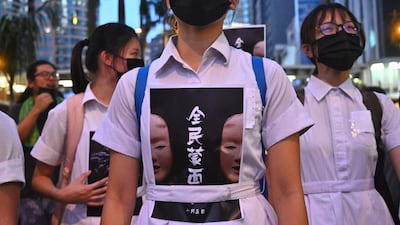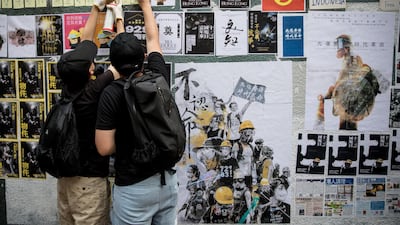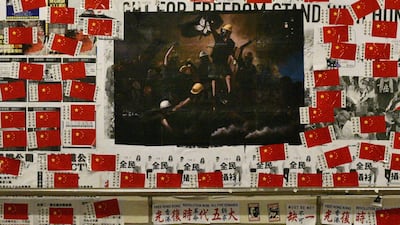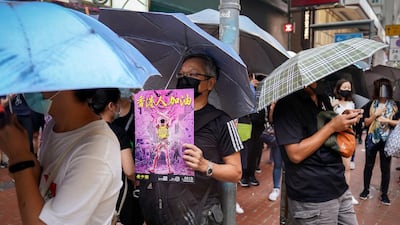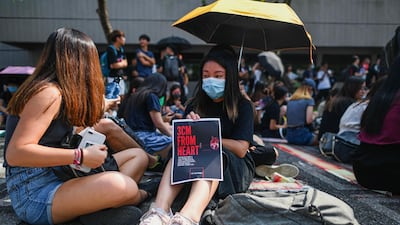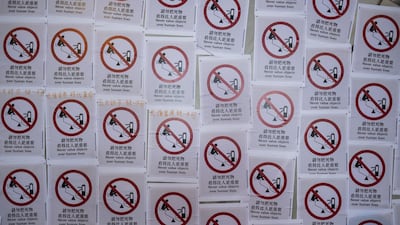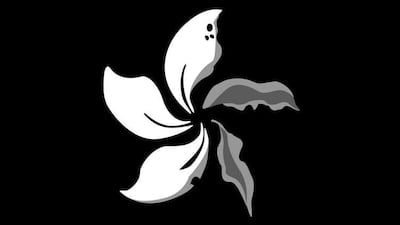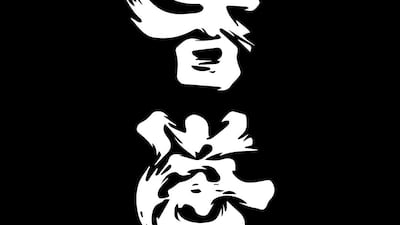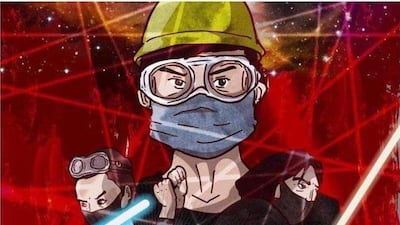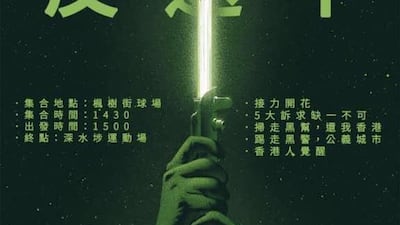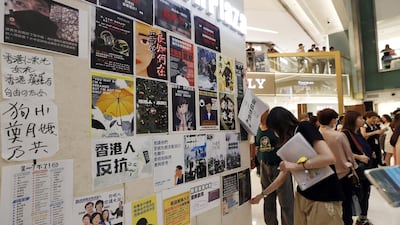As direct clashes between police and protesters in Hong Kong began to dwindle this week, observers may assume the city is returning to normal. One look at the posters covering the city’s walls, however, reveals the Hong Kongers’ struggle against the government is still very much alive.
In this violent confrontation, no leadership has emerged. However, for certain activities activists gather online to plan. The communications team behind the design and the distribution of the flyers offers a non-violent but never-the-less effective method to join what they call the “revolution of our times”.
At peaceful marches, people hold up flyers that read “Hong Kong” when shown vertical and “Add Oil” when turned horizontal. They would stamp on posters that showed Hong Kong Chief Executive Carrie Lam’s face with Devil horns on top of her head, waving flags that has a withering bauhinia, Hong Kong’s city flower, suggesting the fall of this city – all creations of the "anti-extradition communication team".
“Even as someone who’s holding a neutral stance towards these protests, I have to say it’s hard not to be swayed by their public communication – it is incredibly innovative and effective,” said Claire, a local resident of Hong Kong.
What started out as a small team of fewer than 20 people when the protests broke out in early June has now mushroomed to at least 200 "staff members", alongside willing contributors among ordinary Hong Kong citizens, making this group one of the backbones of the movement against the now-scrapped extradition bill.
The group doesn’t have an office and only exists on social media platforms such as Telegram and LIHKG forum – an information hub for Hong Kong protesters.
"The most important thing is that we cannot for one minute stop our work," one admin of the Telegram group – which has over 200,000 subscribers – told The National. He requested to be named "Charles", a pseudonym he uses to avoid retaliation from the government.
The material collection process is fairly simple, yet demanding. “In order to reach the audience before the sentiment towards one incident dies down, we normally have to make sure we finish our designs and start distribution process within half an hour after that incident,” he said.
“For example, when Yuen Long happened, at least 20 of us gathered together to come up with ideas,” he said, becoming visibly angry. “That night was when the whole city fell into panic mode and we knew we had to do something.”
The Yuen Long incident, was a turning point for the pro-democracy movement in Hong Kong. On July 21, at Yuen Long metro station, triad members from Chinese transnational organised crime syndicates mercilessly beat protesters who were travelling home from protests. Local and international media reported seeing police chatting with the triads. Since then, the public’s trust in the police has plummeted.
The next day, at different metro stations, regular commuters saw flyers mimicking MTR announcement posters, but with the content changed from "Danger! Mind the gap" to "Danger! Popo and gangs work with each other".
There are designers, painters, editors, and programmers in the anti-extradition communication team, said Charles. The rest of the members run the strategy, dealing with issues ranging from monitoring on-the-ground information to targeting audiences based on poster designs.
“For example, for the posters that are expected to go on Lennon Walls in high school campuses, we use a lot of animation so we can get their attention faster,” he elaborated on how the team designs differ based on audience group.
After finishing the design of the flyers, the distribution team – a third team within this group – will distribute them to different Telegram groups. Oftentimes, flyers can be seen in a dozen different groups almost within minutes after the initial distribution. In a few hours, people will see the posters on Lennon Walls – walls covered with graffiti and posters inspired by protest walls featuring musician John Lennon in Prague during the Cold War – in various districts of Hong Kong.
One prominent example of the team's innovative and speedy reaction to events is how it handled the arrest of a protester for possession of a laser. Within an hour of his arrest on August 6, posters emerged across the city that borrowed the Star Wars film franchise style, depicting masked protesters using laser pointers as lightsabres and mocking the police.
Since the majority of the protesters are young students, and school resumed in September, how they juggle between schoolwork and the movement became an unavoidable question.
“Back in the summer, it was fine because we could be fully devoting our time to this group,” he said. “But now, I wake up super early for work related to this group until late afternoon before I fanatically pack my bag and go to school at night.”
“It is, however, not all fancy work,” Charles said, opening up about the looming mental health problem within the group. “Sometimes we feel like we are experiencing unbearable mental health problems with so much negative news – I myself already have an anxiety disorder and I can’t count how many times I’ve had anxiety attacks.”
For them, the fight against the government is far from over and their role is becoming more important as violence level is on the rise.
“Of course I wish we would win this revolution, but even if we did not at the end, the kind of bond we have among Hong Kongers – I’ll remember it for the rest of my life,” he said.
